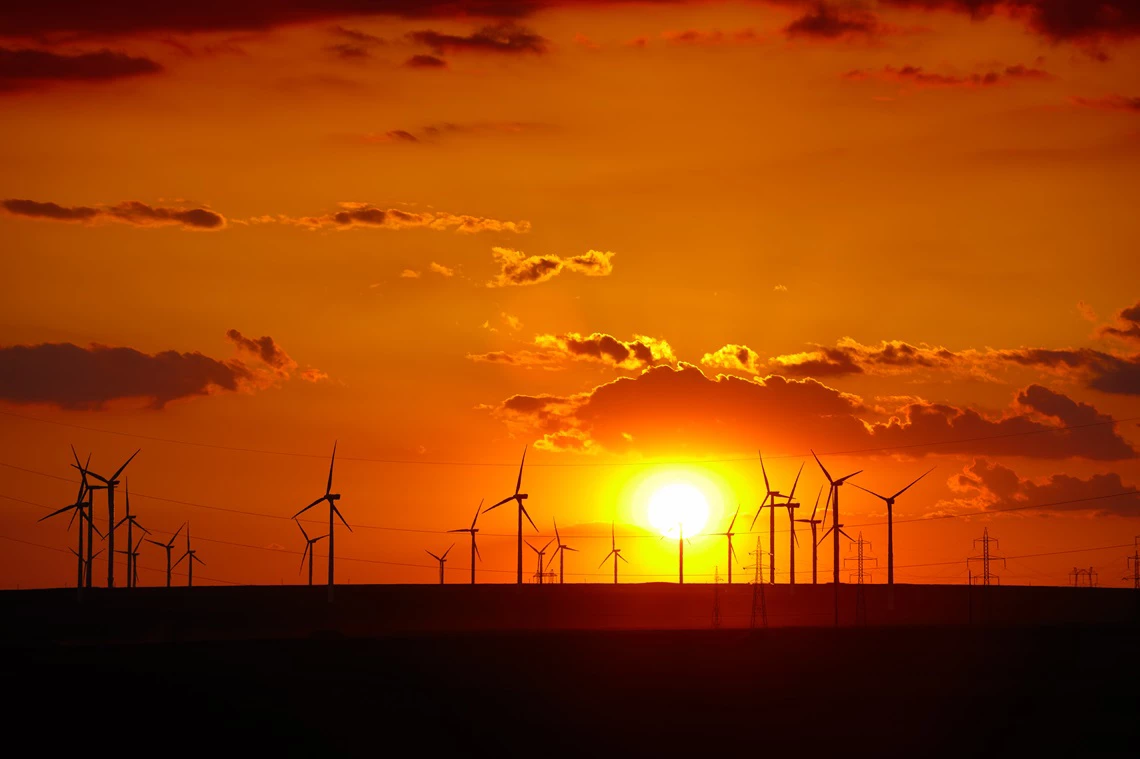 Wind turbines farm at sunset in Romania's Dobrogea Region. Photo: Gabriela Insuratelu/ Shutterstock
Wind turbines farm at sunset in Romania's Dobrogea Region. Photo: Gabriela Insuratelu/ Shutterstock
Last year was the warmest ever recorded for our planet. In the Europe and Central Asia region, all-time high temperatures were recorded in several countries, including Albania, Bulgaria, Romania, and Türkiye, while wildfires affected Bulgaria, North Macedonia, and Türkiye.
Beyond these events, the economic impacts of climate change can be just as considerable. We recently argued that adopting policies to mitigate climate change in the region would contribute to global efforts to limit carbon emissions and slow the impact of global warming. Equally importantly, innovation and technology diffusion related to climate mitigation and adaptation would also help firms upgrade, bolstering flagging domestic investment and sluggish economic growth while creating new jobs. Large investment is necessary for this effort – but needs to be accompanied by complementary pricing, regulatory and other policies to make a change.
The cost of inaction is likely to be high. For example, Uzbekistan’s economy could be 10% smaller by 2050 without action on climate adaptation. High fiscal costs of addressing disasters would absorb valuable resources and may boost government debt. Financial sectors will be strained.
Without efforts to decarbonize and take advantage of lower-cost technologies that reduce emissions, the long-term economic prospects of Europe and Central Asia look challenging. Adoption of clean technologies will improve the competitiveness of early movers, amidst a growing trend towards carbon taxes on imports, such as the European Union’s Carbon Border Adjustment Mechanism (CBAM), which is being implemented fully from 2026.
The countries of Europe and Central Asia are among the world’s largest carbon emitters on a per capita basis, at nearly 7 metric tons per person, little changed since 2000. This is 50% more than the global average.
The region’s emission intensity, measured by emissions per unit of GDP, is also higher than in the EU and most developing regions, even after declining by half since 2000.
Figure: Carbon emissions by world region and subregion, 2020

Large energy subsidies are one of the reasons for the high carbon intensity of Europe and Central Asia. Fossil fuel subsidies amounted to $110 billion in 2020, or 3.6% of regional GDP. Russia alone accounted for $78 billion (5.2% of GDP).
The energy shock of 2021-22 redefined our understanding of energy security, emphasizing the need to diversify energy supply sources and reduce dependence on imported fossil fuels.
But the energy transition will require substantial spending. Kazakhstan will likely require about $1.1 trillion during 2025-2060, or 6% of cumulative GDP, to decarbonize its energy system. Türkiye will need roughly $644 billion (4.8% of GDP) until 2040 to reach net zero.
While public investment for mitigation is likely to be substantial, the region’s private sector will need to play an active role for the transition to succeed. Indeed, globally, private investment is likely to amount to about 70-80% of the total investment in decarbonization.
Yet investment, no matter how large, will not be enough to ensure a clean, affordable, and secure energy supply that reduces emissions and bolsters growth. Countries will require a range of complementary policies, namely:
- Pricing reforms that address market failures to incentivize decarbonization measures. In several countries across Europe and Central Asia, prices for electricity and natural gas paid by domestic consumers do not cover costs. As part of pricing reforms, authorities need to reduce or phase out energy subsidies propping up fuel consumption, helping incentivize continued investment in and use of cleaner sources of energy.
- Social policies to support the most vulnerable after the elimination of fuel subsidies are essential, since an estimated third of people living in region spend 10% or more of their average monthly income on energy bills. Removing subsidies needs to be implemented transparently, as should well-targeted social transfers and policies.
- Tax instruments to facilitate the green transition. Carbon pricing is the most common pricing policy used to help reduce emissions, particularly in the EU. However, an important consideration is that for carbon pricing policies to be effective, they should ideally be implemented after a reduction in fuel subsidies—and not before.
- Regulatory policies are essential for helping achieve emissions reduction. These include mandates for energy efficiency, structural changes to energy demand in the heating sector, and improved standards for appliances. These policies should also include efforts to unbundle integrated electricity and natural gas systems.
- Investment in skills is fundamental for a greener economy. Technological changes always will result in the creation of new jobs that require new skills, and the transition to lower emissions will be no different, shifting the nature of labor demand away from carbon-intensive sectors.
Regardless of the region’s success in reducing emissions, or climate mitigation, climate adaptation is needed across all countries, given the impacts of global warming on economies and other climate change developments. Achieving the optimal mix of environmental, social, and economic objectives won’t be easy and will require big investments and whole-of-society change. But doing will need to be based on country-specific economic circumstances and structures.


Join the Conversation